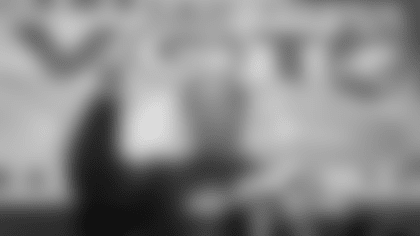Adam from Bellevue, WI
The attached photo, taken by me and my fiancée, a Chiefs fan, on a recent trip to Kansas City, was on display on the Lamar Hunt History Wall in the Founders Club in Arrowhead Stadium. Do you know why the Dallas Texans (now the Kansas City Chiefs) would have received a check in 1962 signed by Vince Lombardi?
The obvious answer is the under-the-table deal for kicker Ben Agajanian. Katie Hermsen, our public affairs manager, checked with Bob Moore, Chiefs historian, and Mike Davidson, associate historian/curator of the Chiefs' Hall of Honor, to learn what they know about the check and here was their response: "It has been our understanding that yes, this $2,000 check was for compensation for a player that was made available to the Packers by the Dallas Texans. Although it is assumed that Ben Agajanian is the most likely player, we are not able to confirm with anything specified in writing from Lamar (Hunt)."
I appreciate that they hedged on their answer without having absolute proof, but I can't imagine it would be payment for anyone other than Agajanian.
This is one of the more bizarre transactions in Packers history, and it either exemplifies how different the business of pro football was back then or how all-powerful and intimidating Lombardi was in NFL circles and even beyond – or perhaps a little bit of both.
First, some background. The American Football League was formed as an eight-team league in 1959 and started play the following fall. As founder and owner of the Dallas Texans, charter members of the AFL, Lamar Hunt was the driving force behind the league's creation.
Not surprisingly, owners of the 12 NFL teams immediately felt threatened by the new league and countered in January 1960 by awarding a franchise to Dallas after dragging their feet on expansion for most of the 1950s. This new 13th NFL team, soon to be nicknamed the Cowboys, also started play in the fall of 1960 to try and thwart the AFL from gaining a foothold in Dallas. By the 1961 season, if not sooner, as competition for players escalated – leading to several court battles – and salaries skyrocketed, it reached a point where the term "at war" became the catch phrase for describing the relationship between the two leagues.
Meanwhile, in Green Bay, the Packers, after dropping their 1961 season opener, had won four straight games over formidable opponents, outscoring them, 148-34, and Lombardi was clearly within grasp of winning his first NFL championship as head coach. Then came the Oct. 17 bombshell: Star player and placekicker Paul Hornung and middle linebacker Ray Nitschke, as privates in the Army Reserve, were ordered to active military duty during the Berlin Crisis. A week later, offensive end Boyd Dowler received his orders.
A month later, when Hornung was starting to get more resistance from his commanding officers over weekend passes that had allowed him to play in games without practicing, the Packers obtained Agajanian as an insurance policy. He had kicked for the New York Giants when Lombardi was an assistant there and for the Texans over the previous three weeks.
Technically, the Texans waived Agajanian, despite him kicking a 51-yard field goal in his final game for them and without having a replacement in mind. After all, the Texans didn't bother to add an experienced kicker to their roster and didn't score on another field goal over their final five games. Nevertheless, the deal had been pre-arranged by two teams that were supposedly "at war." In fact, Lombardi brought Agajanian to Green Bay a week earlier for a tryout while he was still under contract to Dallas. Consequently, Lombardi worked out what was essentially a trade with Texans coach Hank Stram. As a favor for cutting Agajanian, Lombardi offered Stram taxi-squad quarterback Val Keckin, who had shown promise in training camp as an 11th-round draft pick, in exchange.
Curiously, most papers in Wisconsin and Texas didn't bother digging beneath the surface for the real story. But Hank Hollingworth, executive sports editor of the Independent in Long Beach, Calif., where Agajanian lived, did, even before the deal was struck. Lombardi told Hollingworth four days before the Packers acquired Agajanian, "He has been kicking with us, but we have no announcement yet." Lombardi also informed Hollingworth that he was going to ship Keckin as compensation.
"It was a secret trade," Agajanian told me in a 2002 interview. "Hank Stram idolized Vince. So when Vince called, Hank said, 'Sure.' The two leagues didn't talk to each other practically, but it was a secret trade."
Agajanian, in turn, worked out an arrangement with Lombardi where he would spend weekdays at his home in Long Beach and then fly to wherever the Packers were playing on the weekends and be available if Hornung failed to get a pass from the Army to play. Over the final five regular-season games, Agajanian kicked in three, made 8-of-8 extra point tries and 1-of-2 field goal attempts. Lombardi also allowed him during games in Green Bay to have his own propane heater on the sideline and to wear red socks, not green like his teammates. I'm not sure if it was related, but Agajanian wore a size 7½ squared-off kicking boot on his right foot, where he had lost four toes years earlier in an industrial accident.
Agajanian's busiest day was in the NFL Championship Game played in Green Bay on Dec. 31, 1961. He kicked off seven times, while Hornung handled field goals and extra points in a 37-0 victory over the New York Giants.
As for Keckin, he refused to report to Dallas, and Lombardi couldn't force him to sign an AFL contract. "I want to play in our league and I expect to make it someday," Keckin told Art Daley of the Green Bay Press-Gazette at the time. As a result, Keckin soon left the Packers' taxi squad – that day's version of today's practice squads – to join the taxi squad of the NFL Baltimore Colts.
Thus, based on the check you photographed, it appears all but certain that the Texans, who in two years would move to Kansas City, were secretly paid $2,000 instead, months later.
Jon from Luxemburg, WI
I'm curious why Jan Stenerud's name isn't on the Lambeau Field facade. I get that some of the other Hall of Famers like Ted Hendricks and Emlen Tunnell only played here a very short time, so it makes sense to omit them. But Stenerud played four seasons in Green Bay and is in the Packers Hall of Fame. I don't believe Tunnell and Hendricks are. If his contribution to the team was significant enough to make the team hall, wouldn't that seem to justify adding his name to the facade? Is it because he's a kicker?
Actually, the Pro Football Hall of Fame specifies whether a player is a primary contributor or not to a specific team. And occasionally, in cases where a player "contributes about equally" or "in a major way" to two or more clubs, it will list them at times with more than one. The Packers have 28 primary contributors and five secondary contributors, including Stenerud, in Canton. And I wholeheartedly agree with all of the Pro Football Hall of Fame's designations.
Three of the 28 Packers are listed as primary contributors with another team: Reggie White with Philadelphia, and Charles Woodson and Ron Wolf with the Raiders. That makes perfect sense to me.
In fact, I'd argue that there are others on that list who made a bigger contribution to other teams than Stenerud did in Green Bay, including James Lofton, who was a starter when he played in three Super Bowls during his four years with the Buffalo Bills; Jim Ringo, who was selected for three Pro Bowls during the four years that he played center for Philadelphia; Herb Adderley, a starting cornerback for the Dallas Cowboys when they played in two Super Bowls during his three years with the team; and Cal Hubbard, who was an all-pro in his first two seasons with the New York Giants before signing with the Packers.
The five players who are listed as secondary contributors for the Packers are the three you mentioned, as well as Len Ford and Walt KIesling.
Of those five, I believe Tunnell would be the only one, where it could be argued that he contributed in a "major way" to the Packers, even if he isn't in the Packers Hall of Fame. In the many interviews I've had with players from the 1959-61 teams, they spoke as highly of Tunnell as any player on those rosters other than Hornung. Tunnell's leadership was invaluable, and he was still a good player when Lombardi resurrected the franchise over that period. Also, in the more than 50 years since I first started writing about the Packers for my livelihood, my opinion is that Hendricks' play in 1974 topped any other by a Packers defender, including the years when White and Woodson were the Associated Press' choices for NFL Defensive Player of the Year.
Still, I think the people in Canton got it right with Tunnell and Hendricks, as well, because of their brief careers in Green Bay. To me, the 28 names on the Lambeau façade and what those players accomplished to have their names up there is the franchise's ultimate individual honor, and it should be guarded as sacredly as anything in Packers history. Those names and the 13 championship seasons that also are recognized on Lambeau's façade are what separate the Packers from all other teams in the NFL.
Thus, I hope the people in Canton stick to their standards and don't ever cheapen the honor by listing a future inductee as a primary contributor when he doesn't deserve it. I hope they use White and Woodson as their standard of excellence and never forget that for all Tunnell contributed to the Packers he should be the highest bar looking at it from a minimum accomplishment.
Also keep these two things in mind. One, Stenerud played 13 years with Kansas City; and just two full seasons, plus a strike-shortened one and the last four games of another in Green Bay. Two, basically, for whatever reason – it was before I was on the selection committee – every kicking specialist for the Packers from Don Chandler through 1988 was voted into the Packers Hall of Fame except for the here-today, gone tomorrow stand-ins. You may remember some of those names: Booth Lusteg, Lou Michaels, Tom Birney, Max Zendejas – the list could go on. Among Chandler, Chester Marcol and Stenerud, the only one to have had more than three good seasons was Marcol with three and a borderline fourth.
In fact, I think Stenerud belongs in Canton more than he does in the Packers Hall of Fame. I wasn't on the committee when he was elected in 1991, but my understanding was that he was inducted as the first pure placekicker because of his impact on the game's history as much as his statistics. And I would have voted for him for that reason, as well. He, in effect, paved the way for soccer-style kickers to change the game like few other developments in NFL history.
I don't believe Stenerud's two years in Green Bay and his two in Minnesota were viewed as anything more than a footnote to his career by the Pro Football Hall of Fame selection committee. For example, Nick Lowery, Stenerud's successor in Kansas City, scored more career points and had better percentages, but he's not a Hall of Famer because he wasn't at the forefront of a revolutionary vanguard.
Patrick from San Antonio, TX
Was it true that the two teams with the most African-American starters in the NFL and AFL faced off in the first Super Bowl?
Both the Packers and Chiefs had eight each, which may have been more than any other teams in their respective leagues. But to be absolutely certain would require more extensive research than I've done and also establishing certain criteria as to what constituted a starter over a 14-game regular season and two postseason games. It also would entail some other issues. For example, the official play-by-play of the NFL championship played between the Packers and Cowboys in Dallas didn't list the starting lineups.
The Cowboys had more African-American players on their 40-man roster that day. They had 13 compared to the Packers' nine. But if their starters were the same as their projected starters, they would have had six, two fewer than the Packers. The Chiefs also had 13 Black players on their 40-man roster for Super Bowl I.















